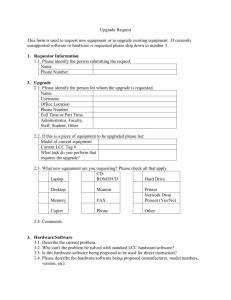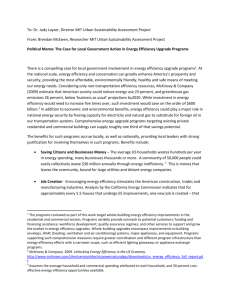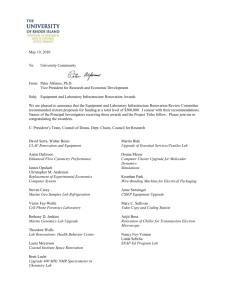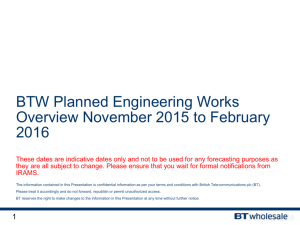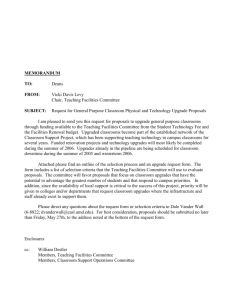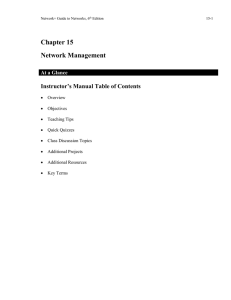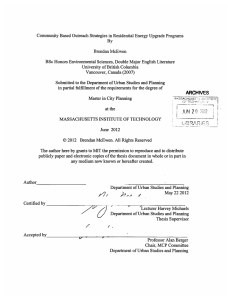Network+ Guide to Networks 6th Edition
advertisement
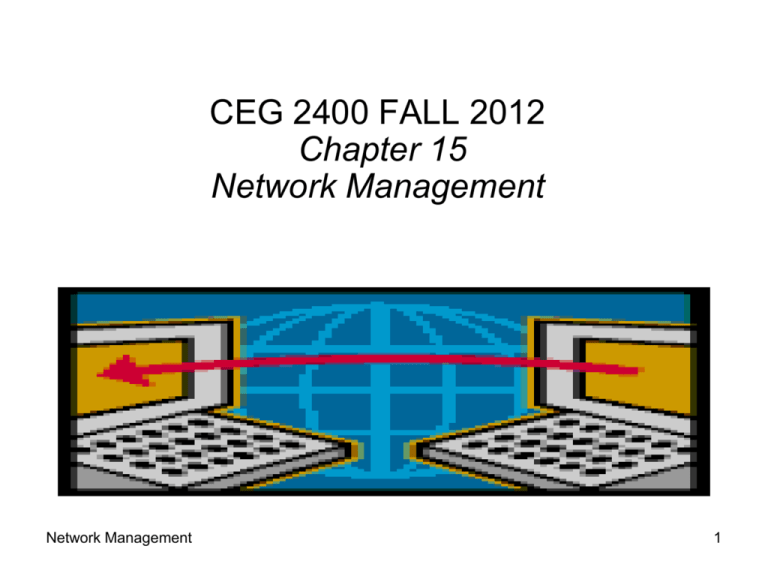
CEG 2400 FALL 2012 Chapter 15 Network Management Network Management 1 Fundamentals of Network Management • Fundamentals of Network management – Assess, monitor, and maintain all network aspects – The amount you manage differs according to network’s size and importance – Several network management disciplines and they all share same goals • Enhance efficiency and performance • Prevent costly downtime and loss – Predict problems before they occur Network Management 2 Documentation • Network features to document – – – – – – – Physical topology Access method Protocols Devices Operating systems Applications Configurations Network Management 3 Documentation • Network diagrams – Graphical representations of network’s devices, connections – Provide broad snapshot of network’s physical or logical topology • Wiring schematic – Graphical representation of network’s wired infrastructure – Detailed form • Includes every wire connecting network devices – Or Less detailed form • Single line represents group of wires connecting several clients to a switch Network Management 4 Network diagram using Cisco symbols Network Management 5 Wiring schematic Network Management 6 Measurements - Baseline • Baseline - network’s current operation state • Gathering baseline data – Many Software applications • Some freeware, some expensive • Compare future and past performance – Critical network, user functions – More data provides more accuracy • Forecasting network traffic patterns Network Management 7 Baseline of daily network traffic Network Management 8 Policies, Procedures, and Regulations • Rules limit chaos, confusion, downtime • State and federal regulations – CALEA (Communications Assistance for Law Enforcement Act) • Telecommunications carriers, equipment manufacturers must provide for surveillance capabilities – HIPAA (Health Insurance Portability and Accountability Act) • Protect medical records security and privacy • Many policies and procedures – Not laws – Best practices to prevent network problems Network Management 9 Fault and Performance Management • Assess network’s status on an ongoing basis • Performance management – Monitor links and devices’ ability to keep up with demand • Fault management – Detection and signaling of device, links, or component faults Network Management 10 Network Management Systems • Enterprise-wide network management systems – Accomplish fault and performance management/monitoring – Polling • Collecting data from multiple networked devices at regular intervals – Agents • Collects information about device’s operation • Provides information to network management application • Various aspects of a device can be managed – Processor, memory, hard disk, NIC, etc. Network Management 11 Network Management Software • Agent-based with network management application can use – MIB (Management Information Base) • Contains managed devices definition, data – SNMP (Simple Network Management Protocol) • • • • Used to communicate managed device information Part of TCP/IP suite SNMPv3: most secure version of the protocol SNMPv2 still widely used Network Management 12 Network management architecture Network Management 13 System and Event Logs Windows • Log – File that contains recorded conditions recognized by operating system • Event log – Windows-based computer log containing monitored device information • Event Viewer - used to view log information in Windows Network Management 14 System and Event Logs Linux or UNIX • Syslog function – Standard for generating, storing, and processing messages about events on Linux or UNIX – Data written to a system log • Using logs for fault management – Logs keep history – Information collected does not always point to problem – Logs must be monitored for errors – There are applications used for viewing, filtering information Network Management 15 Traffic Shaping • Traffic shaping – Manage type and amount of traffic traversing network – Goals • Assure timely delivery of most important traffic • Offer best possible performance for all users – Not without controversy • Techniques – Traffic policing • Limit traffic volume flowing in and out of interface during specified time period by importance • Limit throughput rate for an interface Network Management 16 Traffic volume before and after applying limits Network Management 17 Traffic Shaping • Traffic prioritization technique – Treating more important traffic preferentially – Prioritization based on characteristics • • • • Protocol IP address User group Service or application Network Management 18 Caching • Caching – Local storage of frequently needed files – Allows quick access • Web caching – Web pages stored locally • On host or network, and then delivered to client • ISP cache engine – Network device devoted to storage, frequently requested file delivery – Saves money; lowers WAN traffic Network Management 19 Asset Management • Identifying and tracking hardware and software • First step – Inventory each network node • Benefits – Simplifies maintaining and upgrading network – Provides information about hardware and software costs and benefits Network Management 20 Change Management • Managing change while maintaining network efficiency and availability • Common software and hardware changes range from installing patches to replacing network backbone • Several ways to approach changes – Software Changes – Hardware and Physical Plant Changes Network Management 21 Software Changes • Software upgrades change • Application patches and upgrades • Need to know how to reverse a software upgrade – Software change may create unexpected problems – Be prepared to reverse an upgrade • General steps – – – – Determine whether patch or upgrade is necessary Research change purpose, compatibility, and effects Determine whether changes should apply to all users Determine distribution method Network Management 22 Software Changes • General steps (cont’d.) – – – – – – – – Notify appropriate personnel of intent to change Back up current system Prevent users from accessing system during change Implement the change Test system fully Re-enable access to the system Inform personnel that change is complete Record change in the change management system Network Management 23 Software Changes • NOS (Network Operating System) upgrades change – Most critical upgrade type – Involves significant and potentially drastic changes to the way servers and clients operate – Upgrade requires forethought and rigorous testing – Create a project plan – Complex, far-reaching change – Ensure appropriate budget, resources, and time Network Management 24 Hardware and Physical Plant Changes • Required when network component fails or malfunctions • More commonly performed as an upgrade – Increase capacity, improve performance, and add network functionality • Face same issues as software changes Network Management 25 Hardware and Physical Plant Changes • Adding or upgrading equipment – Take time to research, evaluate, and test unfamiliar equipment – If consistency is a concern • Purchase as much hardware as possible in single order • Purchase from same vendor – Different preparation and implementation requirements for each device type – Devices that are most disruptive and complex to add or upgrade are the most difficult to remove or undo Network Management 26 Hardware and Physical Plant Changes • Cabling upgrades – Can require significant implementation planning • Depending on network size – Troubleshooting cabling problems • Easier with current and accurate wiring schematics – Carefully document existing cable before making upgrades • Ensures future upgrades go smoothly – Consider upgrading in phases – Carefully document after upgrade Network Management 27 Hardware and Physical Plant Changes • Cabling upgrades (cont’d.) – Weigh upgrade importance against disruption potential – Organizations with very small networks • Upgrade own network cabling – Larger organizations • Rely on contractors Network Management 28 Hardware and Physical Plant Changes • Backbone upgrades – Most comprehensive and complex upgrade – Backbone represents main data conduit – Requirements • Extensive planning and personnel efforts – Upgrading entire backbone changes the whole network • Reversing hardware changes – Provide way to reverse hardware upgrade • Reinstall old hardware, If faulty: reinstall not possible – Keep old components safe and nearby • Refer to it for information Network Management 29 Summary • Network management – Assessing, monitoring, and maintaining network devices and connections • Configuration management – Software and hardware configuration documentation • Network management applications use SNMP to communicate with managed devices • System logs and event logs record conditions • Software and hardware upgrades require planning Network Management 30 End of Chapter 15 Questions Network Management 31


